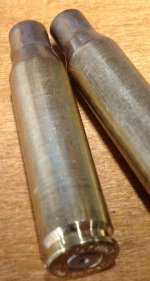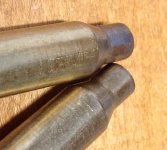You had a good reamer and good oil. If you say the chamber was clean,you were there,I was not.
And if you say your reamer may not have been clean,then you learned something.Thats how we learn!. Next time!.
Really,think about a chip laying across a cutting edge.See how that works in your mind.Even letting the flutes pack tight with chips will spoil your work.The chips will cut,too.They must be loose . Clean often!
I built plastic injection molds for a living. I was sent to Chicago to understudy a Master at polishing steel molds and dies. I've done a lot of it,and mold work is at least as demanding as gun work.
I start with a good reamer,as you did.I don't expect to do any polishing when I'm done. The reamer cuts the most precise chamber you are going to get.Hand work after that..can be great! It should be minimal.The best form and dimension comes directly from the reamer.
Trying to do this work through a receiver? You just don't have access.You cannot see or control.
You only have so many options. Your rifle shoots. It extracts. It is what it is. The brass says your chamber does have..."texture".You won't fix that spinning and sanding in a lathe. You will lose more steel in the places that are already low. You have to stone length wise crossing the grooves.
So,
You can accept it.
You can try something easy..and probably make it worse...like a cordless drill and whatever...
You can pull the barrel and make things "better" by trading a little of this for a little of that. I can't say for sure,your chamber may not be too bad. But it might take .003 or so on the diameter to clean up . I don't think you can make it better with the barrel screwed in.
Hind sight is 20/20!! I'm sure you don't need me to tell you .....a lot of things

.
You screwed a barrel out and in at least once. Second time is cake!
There is a cylindrical portion of the barrel,around the chamber. Maybe Shilen gave you some extra length? Do you have access to a thread cutting lathe?
This rifle has become a learning experience.Maybe you can gain a few more lessons out of it. If you can shorten the breech an inch? Turn and thread a new shank..you will have done that!! If you do that...Has the forward face of the receiver ring been faced square and true? If you are going to build accurate rifles,you might study up on that...if you have not,yet.Opportunity!
It costs big $ to have all this done,but if you can do it...
A mandrel from PTG or Brownells makes it easy.Might cost $100. Are you going to build another rifle? If you have access to a lathe and need to practice making threads...Make a mandrel. Between centers.At least center drill and use a center on the threaded end.
Your finish reamer can cut the full chamber. Its slower than having a rougher,but I have done it more often than not.
If you choose this,we can talk. Now,the laws of trig,There is not a lot of diameter gained with a shallow case taper,but it might clean up fine. At least the inch you cut off will be PERFECT this time!!.And you will gain steel on the diameter.
Another option,that may not perfectly clean all of the chamber,but it will "Improve" it,is going with an "Ackley Improved" reamer.These have less case taper,so at least in the forward 2/3 of the chamber,it will try to clean up.
I'll say again,its up to you. I'd say what you have is safe,and it will shoot. It might shoot very well.
You can shrug,let go,move on.Shoot it.
Sometimes..a guy shrugs,and says " I'll never be happy with it. So I got nothing to lose...I might as well try...."
And you then are free to relax a bit be a little bold,and see just what you can do.
Chalk it up to an education,paying your dues. Buying a guitar don't make you a rock star!!
Don't give up!
We'll help you.


